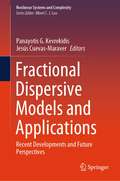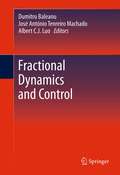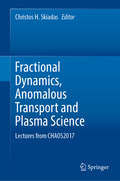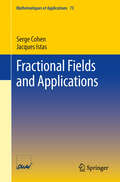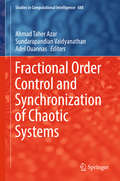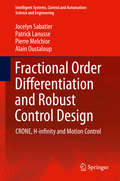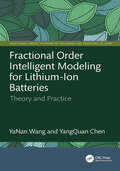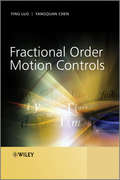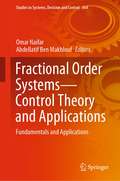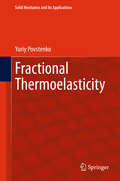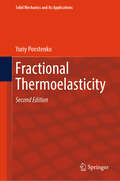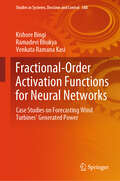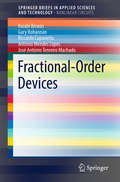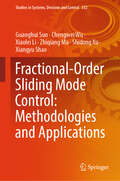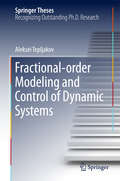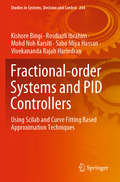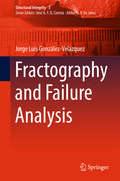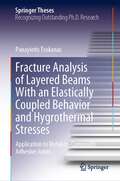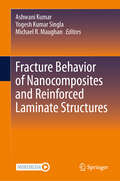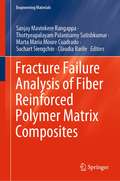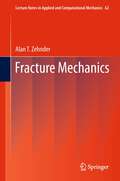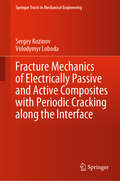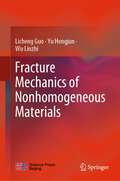- Table View
- List View
Fractional Dispersive Models and Applications: Recent Developments and Future Perspectives (Nonlinear Systems and Complexity #37)
by Jesús Cuevas-Maraver Panayotis G. KevrekidisThis book explores the role of fractional calculus and associated partial differential equations in modeling multiscale phenomena and overlapping macroscopic & microscopic scales, offering an innovative and powerful tool for modeling complex systems. While integer order PDEs have a long-standing history, the novel setting of fractional PDEs opens up new possibilities for the simulation of multi-physics phenomena. The book examines a range of releavant examples that showcase the seamless transition from wave propagation to diffusion or from local to non-local dynamics in both continuum and discrete systems. These systems have been argued as being particularly relevant in contexts such as nonlinear optics, lattice nonlinear dynamical systems, and dispersive nonlinear wave phenomena, where the exploration of the potential fractionality has emerged as a highly active topic for current studies.The volume consists of contributions from a diverse group of active scholars and expertsacross different fields, providing a detailed examination of the field's past, present, and future state-of-the-art in the interplay of fractional PDEs and nonlinear wave phenomena. It is intended to be of wide interest to both seasoned researchers and beginners in the Field of Nonlinear Science. This book sets the stage for the next decade of research and beyond and is a timely and relevant reference of choice for this crucial junction of current research.
Fractional Dynamics and Control
by Albert C. Luo José António Machado Dumitru BaleanuFractional Dynamics and Control provides a comprehensive overview of recent advances in the areas of nonlinear dynamics, vibration and control with analytical, numerical, and experimental results. This book provides an overview of recent discoveries in fractional control, delves into fractional variational principles and differential equations, and applies advanced techniques in fractional calculus to solving complicated mathematical and physical problems.Finally, this book also discusses the role that fractional order modeling can play in complex systems for engineering and science.
Fractional Dynamics, Anomalous Transport and Plasma Science: Lectures From Chaos2017
by Christos H. SkiadasThis book collects interrelated lectures on fractal dynamics, anomalous transport and various historical and modern aspects of plasma sciences and technology. The origins of plasma science in connection to electricity and electric charges and devices leading to arc plasma are explored in the first contribution by Jean-Marc Ginoux and Thomas Cuff. The second important historic connection with plasmas was magnetism and the magnetron. Victor J. Law and Denis P. Dowling, in the second contribution, review the history of the magnetron based on the development of thermionic diode valves and related devices. In the third chapter, Christos H Skiadas and Charilaos Skiadas present and apply diffusion theory and solution strategies to a number of stochastic processes of interest. Anomalous diffusion by the fractional Fokker-Planck equation and Lévy stable processes are studied by Johan Anderson and Sara Moradi in the fourth contribution. They consider the motion of charged particles in a 3-dimensional magnetic field in the presence of linear friction and of a stochastic electric field. Analysis of low-frequency instabilities in a low-temperature magnetized plasma is presented by Dan-Gheorghe Dimitriu, Maricel Agop in the fifth chapter. The authors refer to experimental results of the Innsbruck Q-machine and provide an analytical formulation of the related theory. In chapter six, Stefan Irimiciuc, Dan-Gheorghe Dimitriu, Maricel Agop propose a theoretical model to explain the dynamics of charged particles in a plasma discharge with a strong flux of electrons from one plasma structure to another. The theory and applications of fractional derivatives in many-particle disordered large systems are explored by Z.Z. Alisultanov, A.M. Agalarov, A.A. Potapov, G.B. Ragimkhanov. In chapter eight, Maricel Agop, Alina Gavrilut¸ and Gabriel Crumpei explore the motion of physical systems that take place on continuous but non-differentiable curves (fractal curves). Finally in the last chapter S.L. Cherkas and V.L. Kalashnikov consider the perturbations of a plasma consisting of photons, baryons, and electrons in a linearly expanding (Milne-like) universe taking into account the metric tensor and vacuum perturbations.
Fractional Fields and Applications
by Serge Cohen Jacques IstasThis book focuses mainly on fractional Brownian fields and their extensions. It has been used to teach graduate students at Grenoble and Toulouse's Universities. It is as self-contained as possible and contains numerous exercises, with solutions in an appendix. After a foreword by Stéphane Jaffard, a long first chapter is devoted to classical results from stochastic fields and fractal analysis. A central notion throughout this book is self-similarity, which is dealt with in a second chapter with a particular emphasis on the celebrated Gaussian self-similar fields, called fractional Brownian fields after Mandelbrot and Van Ness's seminal paper. Fundamental properties of fractional Brownian fields are then stated and proved. The second central notion of this book is the so-called local asymptotic self-similarity (in short lass), which is a local version of self-similarity, defined in the third chapter. A lengthy study is devoted to lass fields with finite variance. Among these lass fields, we find both Gaussian fields and non-Gaussian fields, called Lévy fields. The Lévy fields can be viewed as bridges between fractional Brownian fields and stable self-similar fields. A further key issue concerns the identification of fractional parameters. This is the raison d'être of the statistics chapter, where generalized quadratic variations methods are mainly used for estimating fractional parameters. Last but not least, the simulation is addressed in the last chapter. Unlike the previous issues, the simulation of fractional fields is still an area of ongoing research. The algorithms presented in this chapter are efficient but do not claim to close the debate.
Fractional Order Control and Synchronization of Chaotic Systems
by Ahmad Taher Azar Sundarapandian Vaidyanathan Adel OuannasThe book reports on the latest advances in and applications of fractional order control and synchronization of chaotic systems, explaining the concepts involved in a clear, matter-of-fact style. It consists of 30 original contributions written by eminent scientists and active researchers in the field that address theories, methods and applications in a number of research areas related to fractional order control and synchronization of chaotic systems, such as: fractional chaotic systems, hyperchaotic systems, complex systems, fractional order discrete chaotic systems, chaos control, chaos synchronization, jerk circuits, fractional chaotic systems with hidden attractors, neural network, fuzzy logic controllers, behavioral modeling, robust and adaptive control, sliding mode control, different types of synchronization, circuit realization of chaotic systems, etc. In addition to providing readers extensive information on chaos fundamentals, fractional calculus, fractional differential equations, fractional control and stability, the book also discusses key applications of fractional order chaotic systems, as well as multidisciplinary solutions developed via control modeling. As such, it offers the perfect reference guide for graduate students, researchers and practitioners in the areas of fractional order control systems and fractional order chaotic systems.
Fractional Order Differentiation and Robust Control Design
by Alain Oustaloup Jocelyn Sabatier Patrick Lanusse Pierre MelchiorThis book provides an overview of the research done and results obtained during the last ten years in the fields of fractional systems control, fractional PI and PID control, robust and CRONE control, and fractional path planning and path tracking. Coverage features theoretical results, applications and exercises. The book will be useful for post-graduate students who are looking to learn more on fractional systems and control. In addition, it will also appeal to researchers from other fields interested in increasing their knowledge in this area.
Fractional Order Intelligent Modeling for Lithium-Ion Batteries: Theory and Practice (Fractional Order Thinking in Exploring the Frontiers of STEM)
by YangQuan Chen YaNan WangThis book focuses on fractional order (non-integer order) modeling (FOM) techniques coupled with deep neural network-based intelligent modeling methods for lithium-ion batteries (LIBs) and battery management systems (BMS) in general. It provides the first one-stop resource on FOM for LIBs with case studies using real operational data sets.With the rapid growth of electric vehicles and energy storage systems, battery technology has become critical to global energy solutions. Fractional Order Intelligent Modeling for Lithium-Ion Batteries: Theory and Practice aims to provide several accurate and effective intelligent modeling algorithms for the next generation of advanced BMS. Key topics include intelligent battery modeling, fractional-order modeling, physics-informed machine learning, state estimation, and degradation analysis. By integrating AI and physics-informed machine learning techniques with fractional-order modeling methods, this book presents several innovative solutions for next-generation battery management systems.This title will serve as an invaluable resource for researchers and advanced students in the fields of transportation, energy storage, and power systems, as well as those studying electric vehicles, control theory, machine learning, and fractional calculus-based modeling.
Fractional Order Motion Controls
by Yangquan Chen Ying LuoCovering fractional order theory, simulation and experiments, this book explains how fractional order modelling and fractional order controller design compares favourably with traditional velocity and position control systems. The authors systematically compare the two approaches using applied fractional calculus. Stability theory in fractional order controllers design is also analysed. Presents material suitable for a variety of real-world applications, including hard disk drives, vehicular controls, robot control and micropositioners in DNA microarray analysisIncludes extensive experimental results from both lab bench level tests and industrial level, mass-production-ready implementationsCovers detailed derivations and numerical simulations for each caseDiscusses feasible design specifications, ideal for practicing engineersThe book also covers key topics including: fractional order disturbance cancellation and adaptive learning control studies for external disturbances; optimization approaches for nonlinear system control and design schemes with backlash and friction. Illustrations and experimental validations are included for each of the proposed control schemes to enable readers to develop a clear understanding of the approaches covered, and move on to apply them in real-world scenarios.
Fractional Order Systems—Control Theory and Applications: Fundamentals and Applications (Studies in Systems, Decision and Control #364)
by Omar Naifar Abdellatif Ben MakhloufThis book aims to bring together the latest innovative knowledge, analysis, and synthesis of fractional control problems of nonlinear systems as well as some related applications. Fractional order systems (FOS) are dynamical systems that can be modelled by a fractional differential equation carried with a non-integer derivative. In the last few decades, the growth of science and engineering systems has considerably stimulated the employment of fractional calculus in many subjects of control theory, for example, in stability, stabilization, controllability, observability, observer design, and fault estimation. The application of control theory in FOS is an important issue in many engineering applications. So, to accurately describe these systems, the fractional order differential equations have been introduced.
Fractional Thermoelasticity
by Yuriy PovstenkoThis book is devoted to fractional thermoelasticity, i. e. thermoelasticity based on the heat conduction equation with differential operators of fractional order. Readers will discover how time-fractional differential operators describe memory effects and space-fractional differential operators deal with the long-range interaction. Fractional calculus, generalized Fourier law, axisymmetric and central symmetric problems and many relevant equations are featured in the book. The latest developments in the field are included and the reader is brought up to date with current research. The book contains a large number of figures, to show the characteristic features of temperature and stress distributions and to represent the whole spectrum of order of fractional operators. This work presents a picture of the state-of-the-art of fractional thermoelasticity and is suitable for specialists in applied mathematics, physics, geophysics, elasticity, thermoelasticity and engineering sciences. Corresponding sections of the book may also be used as additional reading material for courses on heat and mass transfer, continuum mechanics, thermal stresses as well as in fractional calculus and its applications for graduate and postgraduate students. Extensive references are included in order to stimulate further studies.
Fractional Thermoelasticity (Solid Mechanics and Its Applications #278)
by Yuriy PovstenkoThis new edition offers expanded coverage of fractional calculus, including Riemann–Liouville fractional integrals, Riemann–Liouville and Caputo fractional derivatives, Riesz fractional operators, and Mittag-Leffler and Wright functions. Additionally, it provides a comprehensive examination of fractional heat conduction and related theories of thermoelasticity. Readers will gain insights into the concepts of time and space nonlocality and their impact on the generalizations of Fourier's law in thermoelasticity. This edition presents a detailed formulation of the problem of heat conduction in different domains and the associated thermal stresses, covering topics such as the fundamental solution to the Dirichlet problem, constant boundary conditions for temperature, and the fundamental solution to the physical Neumann problem. New insights into time-harmonic heat impact on the boundary have also been added. Cracks in the framework of fractional thermoelasticity are also considered.
Fractional-Order Activation Functions for Neural Networks: Case Studies on Forecasting Wind Turbines' Generated Power (Studies in Systems, Decision and Control #588)
by Kishore Bingi Ramadevi Bhukya Venkata Ramana KasiThis book suggests the development of single and multi-layer fractional-order neural networks that incorporate fractional-order activation functions derived using fractional-order derivatives. Activation functions are essential in neural networks as they introduce nonlinearity, enabling the models to learn complex patterns in data. However, traditional activation functions have limitations such as non-differentiability, vanishing gradient problems, and inactive neurons at negative inputs, which can affect the performance of neural networks, especially for tasks involving intricate nonlinear dynamics. To address these issues, fractional-order derivatives from fractional calculus have been proposed. These derivatives can model complex systems with non-local or non-Markovian behavior. The aim is to improve wind power prediction accuracy using datasets from the Texas wind turbine and Jeju Island wind farm under various scenarios. The book explores the advantages of fractional-order activation functions in terms of robustness, faster convergence, and greater flexibility in hyper-parameter tuning. It includes a comparative analysis of single and multi-layer fractional-order neural networks versus conventional neural networks, assessing their performance based on metrics such as mean square error and coefficient of determination. The impact of using machine learning models to impute missing data on the performance of networks is also discussed. This book demonstrates the potential of fractional-order activation functions to enhance neural network models, particularly in predicting chaotic time series. The findings suggest that fractional-order activation functions can significantly improve accuracy and performance, emphasizing the importance of advancing activation function design in neural network analysis. Additionally, the book is a valuable teaching and learning resource for undergraduate and postgraduate students conducting research in this field.
Fractional-Order Devices
by José António Tenreiro Machado Karabi Biswas Gary Bohannan Riccardo Caponetto António Mendes LopesThis book focuses on two specific areas related to fractional order systems - the realization of physical devices characterized by non-integer order impedance, usually called fractional-order elements (FOEs); and the characterization of vegetable tissues via electrical impedance spectroscopy (EIS) - and provides readers with new tools for designing new types of integrated circuits. The majority of the book addresses FOEs. The interest in these topics is related to the need to produce "analogue" electronic devices characterized by non-integer order impedance, and to the characterization of natural phenomena, which are systems with memory or aftereffects and for which the fractional-order calculus tool is the ideal choice for analysis. FOEs represent the building blocks for designing and realizing analogue integrated electronic circuits, which the authors believe hold the potential for a wealth of mass-market applications. The freedom to choose either an integer- or non-integer-order analogue integrator/derivator is a new one for electronic circuit designers. The book shows how specific non-integer-order impedance elements can be created using materials with specific structural properties. EIS measures the electrical impedance of a specimen across a given range of frequencies, producing a spectrum that represents the variation of the impedance versus frequency - a technique that has the advantage of avoiding aggressive examinations. Biological tissues are complex systems characterized by dynamic processes that occur at different lengths and time scales; this book proposes a model for vegetable tissues that describes the behavior of such materials by considering the interactions among various relaxing phenomena and memory effects.
Fractional-Order Sliding Mode Control: Methodologies and Applications (Studies in Systems, Decision and Control #532)
by Guanghui Sun Xiaolei Li Chengwei Wu Xiangyu Shao Zhiqiang Ma Shidong XuThis book delves deep into fractional-order control and fractional-order sliding mode techniques, addressing key challenges in the control design of linear motor systems and control for the deployment of space tethered systems. Innovative strategies such as adaptive fractional-order sliding mode control and fractional-order fuzzy sliding mode control schemes are devised to enhance system performance. Divided into three parts, it covers a brief view of fractional-order control strength in modeling and control, fractional-order sliding mode control of linear motor systems, and fractional-order sliding mode control for the deployment of space tethered systems. Each chapter offers valuable insights and solutions. Simulations and experiments validate the efficacy of these approaches, making this book essential for researchers, engineers, and practitioners in control systems and aerospace engineering.
Fractional-order Modeling and Control of Dynamic Systems
by Aleksei TepljakovThis book reports on an outstanding research devoted to modeling and control of dynamic systems using fractional-order calculus. It describes the development of model-based control design methods for systems described by fractional dynamic models. More than 300 years had passed since Newton and Leibniz developed a set of mathematical tools we now know as calculus. Ever since then the idea of non-integer derivatives and integrals, universally referred to as fractional calculus, has been of interest to many researchers. However, due to various issues, the usage of fractional-order models in real-life applications was limited. Advances in modern computer science made it possible to apply efficient numerical methods to the computation of fractional derivatives and integrals. This book describes novel methods developed by the author for fractional modeling and control, together with their successful application in real-world process control scenarios.
Fractional-order Systems and PID Controllers: Using Scilab and Curve Fitting Based Approximation Techniques (Studies in Systems, Decision and Control #264)
by Rosdiazli Ibrahim Sabo Miya Hassan Kishore Bingi Mohd Noh Karsiti Vivekananda Rajah HarindranThis book presents a detailed study on fractional-order, set-point, weighted PID control strategies and the development of curve-fitting-based approximation techniques for fractional-order parameters. Furthermore, in all the cases, it includes the Scilab-based commands and functions for easy implementation and better understanding, and to appeal to a wide range of readers working with the software. The presented Scilab-based toolbox is the first toolbox for fractional-order systems developed in open-source software. The toolboxes allow time and frequency domains as well as stability analysis of the fractional-order systems and controllers. The book also provides real-time examples of the control of process plants using the developed fractional-order based PID control strategies and the approximation techniques. The book is of interest to readers in the areas of fractional-order controllers, approximation techniques, process modeling, control, and optimization, both in industry and academia. In industry, the book is particularly valuable in the areas of research and development (R&D) as well as areas where PID controllers suffice – and it should be noted that around 80% of low-level controllers in industry are PID based. The book is also useful where conventional PIDs are constrained, such as in industries where long-term delay and non-linearity are present. Here it can be used for the design of controllers for real-time processes. The book is also a valuable teaching and learning resource for undergraduate and postgraduate students.
Fractions = Trouble!
by Claudia Mills G. Brian KarasIf Wilson Williams thought multiplication was difficult, he is finding fractions impossible. And when his parents hire a math tutor for him, he is sure he's the only kid in the history of Hill Elementary to have one. Wilson is determined to make sure that no one finds out, not even his best friend, Josh. At least his pet hamster, Pip, is sympathetic. Pip is going to be part of Wilson's science fair project, because any project with hamsters in it is bound to be wonderful. But Josh has the coolest project of all: at what temperature does a pickle explode? Unfortunately, it looks as if Wilson's secret may end up exploding their friendship. Claudia Mills' Fractions = Trouble is a fun and thoroughly relatable story that Kirkus Reviews calls an "excellent selection for early chapter-book readers. "
Fractivism: Corporate Bodies and Chemical Bonds
by Sara Ann WylieFrom flammable tap water and sick livestock to the recent onset of hundreds of earthquakes in Oklahoma, the impact of fracking in the United States is far-reaching and deeply felt. In Fractivism Sara Ann Wylie traces the history of fracking and the ways scientists and everyday people are coming together to hold accountable an industry that has managed to evade regulation. Beginning her story in Colorado, Wylie shows how nonprofits, landowners, and community organizers are creating novel digital platforms and databases to track unconventional oil and gas well development and document fracking's environmental and human health impacts. These platforms model alternative approaches for academic and grassroots engagement with the government and the fossil fuel industry. A call to action, Fractivism outlines a way forward for not just the fifteen million Americans who live within a mile of an unconventional oil or gas well, but for the planet as a whole.
Fractography and Failure Analysis
by Jorge Luis González-VelázquezThis book presents fractography and failure analysis at a level that is accessible for non-expert readers, without losing scientific rigor. It offers a comprehensive description of fracture surfaces in engineering materials, with an emphasis on metals, and of the methodology for the observation of fracture surfaces. It also discusses in detail the main fracture mechanisms and their corresponding fracture surfaces, including brittle, ductile, fatigue, and environmental fractures. The last chapter is dedicated to the use of fractography in determining of the causes component failure. In modern engineering, the analysis of fractured components is a common practice in many fields, such as integrity management systems, materials science research, and failure investigations. As such this book is useful for engineers, scientists, engineering students, loss adjuster surveyors and any professional dealing with fractured components.
Fracture Analysis of Layered Beams With an Elastically Coupled Behavior and Hygrothermal Stresses: Application to Metal-to-Composite Adhesive Joints (Springer Theses)
by Panayiotis TsokanasThis book presents an analytical framework for calculating the fracture toughness of generally layered beam structures with an elastically coupled response and hygrothermal stresses. The beam under study features several peculiarities: it consists of multiple layers of dissimilar materials, features bending-extension coupling, and contains residual hygrothermal stresses. Here, a generic analytical model is proposed to compute the energy release rate and the mode mixity. Mechanics of composite materials, crack closure integral, and energetic methods are among the theoretical tools employed for developing the model.A wealth of new closed-form expressions is presented, together with their validation through finite element analyses, which enables investigating various material systems and testing configurations. Experimentalists will find directions for the design and interpretation of delamination tests on laminated composites with uncommon stacking sequences. At the same time, theoreticians can exploit the analytical solution as a benchmark test for more refined analytical and numerical models. Furthermore, the book gives novel insights into the fracture behavior of a titanium-to-CFRP adhesive joint, which is intended for application in the hybrid laminar flow control of a future aircraft. It reports on experiments and theoretical analyses that help understand the behavior of this novel joint. All in all, this book offers extensive updates on methods for fracture analysis of materials with an elastically coupled behavior and residual stresses. It addresses students, researchers, and engineers alike.
Fracture Behavior of Nanocomposites and Reinforced Laminate Structures
by Ashwani Kumar Yogesh Kumar Singla Michael R. MaughanThis contributed volume is designed for fundamental understanding of fracture behavior of composites applied in core industrial sectors such as mechanical, electronics, Automotive, civil structures, and aerospace research and fills the gap of knowledge on fracture analysis. The book is primarily written for senior undergraduates, graduate students, and academic researchers in above mentioned fields.
Fracture Failure Analysis of Fiber Reinforced Polymer Matrix Composites (Engineering Materials)
by Suchart Siengchin Sanjay Mavinkere Rangappa Thottyeapalayam Palanisamy Satishkumar Marta Maria Moure Cuadrado Claudia BarileThis book presents a unified approach to fracture behavior of natural and synthetic fiber-reinforced polymer composites on the basis of fiber orientation, the addition of fillers, characterization, properties and applications. In addition, the book contains an extensive survey of recent improvements in the research and development of fracture analysis of FRP composites that are used to make higher fracture toughness composites in various applications.The FRP composites are an emerging area in polymer science with many structural applications. The rise in materials failure by fracture has forced scientists and researchers to develop new higher strength materials for obtaining higher fracture toughness. Therefore, further knowledge and insight into the different modes of fracture behavior of FRP composites are critical to expanding the range of their application.
Fracture Mechanics
by Alan T. ZehnderFracture mechanics is a vast and growing field. This book develops the basic elements needed for both fracture research and engineering practice. The emphasis is on continuum mechanics models for energy flows and crack-tip stress- and deformation fields in elastic and elastic-plastic materials. In addition to a brief discussion of computational fracture methods, the text includes practical sections on fracture criteria, fracture toughness testing, and methods for measuring stress intensity factors and energy release rates. Class-tested at Cornell, this book is designed for students, researchers and practitioners interested in understanding and contributing to a diverse and vital field of knowledge.
Fracture Mechanics of Electrically Passive and Active Composites with Periodic Cracking along the Interface (Springer Tracts in Mechanical Engineering)
by Volodymyr Loboda Sergey KozinovThis book offers a comprehensive and timely review of the fracture behavior of bimaterial composites consisting of periodically connected components, i.e. of bimaterial composites possessing periodical cracks along the interface. It first presents an overview of the literature, and then analyzes the isotropic, anisotropic and piezoelectric/dielectric properties of bimaterial components, gradually increasing the difficulty of the solutions discussed up to the coupled electromechanical problems. While in the case of isotropic and anisotropic materials it covers the problems generated by an arbitrary set of cracks, for the piezoelectric materials it focuses on studying the influence of the electric permittivity of the crack’s filler, using not only a simple, fully electrically permeable model, but also a physically realistic, semi-permeable model. Throughout the analyses, the effects of the contact of the crack faces are taken into account so as to exclude the physically unrealistic interpenetration of the composite components that are typical of the classical open model. Further, the book derives and examines the mechanical and electromechanical fields, stress and electric intensity factors in detail. Providing extensive information on the fracture processes taking place in composite materials, the book helps readers become familiar with mathematical methods of complex function theory for obtaining exact analytical solutions.
Fracture Mechanics of Nonhomogeneous Materials
by Licheng Guo Yu Hongjun Wu LinzhiThis book perfects the theoretical system of fracture mechanics of nonhomogeneous materials through the establishment of the piecewise exponential model and expands the fracture research scope to nonhomogeneous materials containing complex interfaces through proposing the domain-independent interaction integral concept. The piecewise exponential model has overcome the problem of fracture mechanics of nonhomogeneous materials and clarified the doubt of traditional exponential models in recent 30 years. The domain-independent interaction integral method is not affected by material nonhomogeneity and discontinuity, which greatly facilitates its numerical implementation in the investigation of fracture behaviors of nonhomogeneous materials with complex interfaces.
